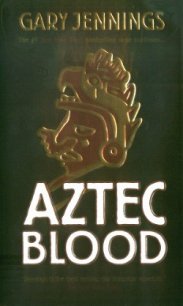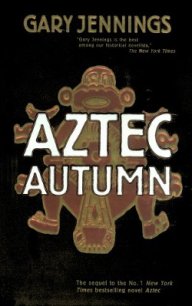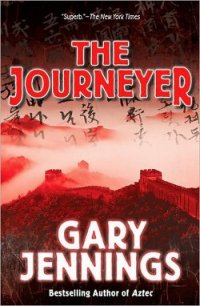Aztec - Jennings Gary (книги хорошем качестве бесплатно без регистрации TXT) 📗
Well, that is only a theory, and only my own. But you, Your Excellency, and you, reverend friars, should eventually have opportunity to verify or disprove it. This island of Tenochtitlan-Mexico sits even more uneasily than Xaltocan upon the ooze of the lake floor, and it shifts its position now and then, sometimes violently. Soon or later, you will feel a convulsive quake of the earth. See for yourselves, then, what you feel in your reverend parts.
There was really no reason for our party to have lingered in Zaachila and its environs for as many days as we did, except that it was a most pleasant place for us to rest before we undertook the long and grueling climb through the mountains beyond—and except for the fact that Blood Glutton, belying his grizzled years, seemed determined to leave not a single one of the accessible Tzapoteca beauties neglected. I confined myself to seeing the local sights. I did not even exert myself to seek trade bargains; for one reason, the most prized local commodity, the famous dye, was out of stock.
You call that dye cochineal, and you may know that it is obtained from a certain insect, the nocheztli. The insects live in millions on immense, cultivated plantations of the one special variety of nopali cactus on which they feed. The insects mature all at the same season, and their cultivators brush them off the cactus into bags and kill them, either by dipping the bags in boiling water or hanging them in a steam house or leaving them in the hot sun. Then the insects are dried until they are wrinkled seeds, and are sold by weight. Depending on how they were killed—boiled, steamed, or baked—they yield when crushed a dye of jacinth yellow-red or a bright scarlet or that particular luminous carmine which is obtainable from no other source. I tell all this because the Tzapoteca's latest crop had been bought in its entirety by an earlier and northbound Mexicatl trader, that one with whom I had conversed way back in the Xochimilca country, and there was no more dye to be had that year, for even the most pampered insects cannot be hurried.
I did remember what that same trader had told me: of a new and even more rare purple dye which was somehow mysteriously connected with snails and a people called The Strangers. I asked of the interpreter Red River and several of his merchant friends what they might know of the matter, but all I got from anybody was a blank look and an echo: "Purple? Snails? Strangers?" So I made only one trading transaction in Zaachila, and it was not the sort that a typically tightfisted pochteatl would have made.
Old Red River arranged for me to pay a courtesy call on Kosi Yuela, the Bishosu Ben Zaa, which means the Revered Speaker of the Cloud People, and that ruling lord kindly treated me to a tour of his palace so I might admire its luxurious furnishings. Two of those inspired my acquisitive interest. One was the Bishosu's queen, Pela Xila, a woman to make a man salivate, but I contented myself with kissing the earth to her. When I saw the other thing, however—a beautifully worked feather tapestry—I determined to have it.
"But that was made by one of your own countrymen," said my host. He sounded slightly peeved that I should stand staring at a Mexicatl artifact instead of exclaiming over the products of his own Cloud People: the interestingly mottled draperies in the throne room, for instance—colored by having been tied in knots and dyed, then relied and redyed, several times over.
Nodding at the tapestry, I said, "Let me hazard a guess, my lord. The feather-work artist was a wayfarer named Chimali."
Kosi Yuela smiled. "You are right. He stayed in these parts for some time, making sketches of the mosaics of Lyobaan. And then he had nothing with which to pay the innkeeper, except that tapestry. The landlord accepted it, though unhappily, and later came to complain to me. So I reimbursed him, for I trust that the artist will eventually return and redeem the thing."
"I am sure he will," I said, "for I have long known Chimali. Therefore I may see him before you do. If you would allow it, my lord, I shall be glad to pay his debt and assume the pledge myself."
"Why, that would be kind of you," said the Bishosu. "A most generous favor to your friend and to us as well."
"Not at all," I said. "I merely repay your kindness to him. And anyway"—I remembered the day I had led a frightened Chimali home with him wearing a pumpking head—"it will not be the first time I have helped my friend out of a temporary difficulty."
Chimali must have lived well during his stay at the hostel; it cost me quite a stack of tin and copper snippets to settle his bill. But the tapestry was easily worth ten or twenty times that much. Today it would probably be worth a hundred times as much, since almost all our feather works have been destroyed, and no more have been made in recent years. Either the feather artists were also destroyed, or they have lost all heart for the creation of beauty. So it may be that Your Excellency has never seen one of those shimmering pictures.
The work was more delicate, difficult, and time-consuming than any mode of painting, sculpture, or goldsmithery. The artist began with a cloth of the finest cotton, tightly stretched over a panel of wood. On the cloth he lightly drew the lines of the picture he envisioned. Then, painstakingly, he filled in all the spaces with colored feathers, using only the soft, plumed shaft part, the quill cut away. He attached each of the thousands and thousands of feather, one by one, with a minute dab of liquid oli. Some so-called artists were uncaring slovens who used only white birds' feathers which they tinted with paints and dyes as required, and trimmed their shapes to fit the more intricate places in the design. But a true artist used only naturally colored feathers, and carefully chose exactly the right hue from all their gradations of colors, and used large or small, straight or curved feathers as the picture demanded. I say "large," but there was seldom a feather in any of those works bigger than a violet's petal, and the smallest would be about the size of a human eyelash. An artist might have to delve and compare and select from among a stock of feathers that would fill this room we sit in.
I do not know why Chimali had that one time forsaken his paints, but he had chosen the feather medium to do a woodland scene, and he had done it masterfully. In a sunny forest glade, a jaguar lay resting among flowers, butterflies, and birds. Every pictured bird was done in the feathers of its species, though every jay, for instance, would have required Chimali's winnowing from the tiniest blue feathers of perhaps hundreds of real jays. The greenery was not just masses of green feathers; it seemed that every individual blade of grass and leaf of tree was a separate feather of a subtly different green. I counted more than thirty minuscule feathers composing just one small brown and yellow butterfly. Chimali's signature was the only part of the picture done in a single unmodulated color—in the feathers of the scarlet macaw—and the handprint was modestly small, less than half life size.
I took the tapestry to our lodgings, and gave it to Cozcatl, and told him to leave just the scarlet hand affixed. When he had peeled off every other feather of the picture, I heaped them all, inextricably mixed, onto the cloth backing. I bundled and tied it tightly, and took it again to the palace. Kosi Yuela was absent, but his queen Pela Xila received me and I left the wadded parcel with her, saying:
"My lady, in case the artist Chimali should come back this way before I meet him, have the goodness to give him this. Tell him it is a token—that all his other debts will be similarly repaid."




